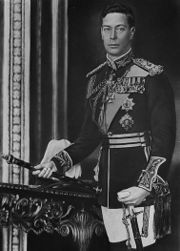King George VI: Difference between revisions
Seijbersen (talk | contribs) removed extra comma |
No edit summary |
||
| Line 2: | Line 2: | ||
|[[Image:KingGeorge2.jpg|right|180px]] | |[[Image:KingGeorge2.jpg|right|180px]] | ||
'''George VI''' (Albert Frederick Arthur George Windsor) became King of the United Kingdom and the British Dominions on December 11, 1936 after his older brother, Edward VIII abdicated the throne. His Majesty George VI reigned as king through WWII, and is known for boosting national moral by refusing to leave London for safer lodging. In the years after WWII his health began to deteriorate, perhaps due to a combination of stress and excessive smoking. In 1951 a malignant tumor was found on one lung, and both the tumor and the lung were removed in the fall of that year. King George VI slowly regained his strength, then quietly passed away in his sleep on February 8, 1952. | '''George VI''' (Albert Frederick Arthur George Windsor) became King of the United Kingdom and the British Dominions on December 11, 1936 after his older brother, Edward VIII abdicated the throne. His Majesty George VI reigned as king through WWII, and is known for boosting national moral by refusing to leave London for safer lodging. In the years after WWII his health began to deteriorate, perhaps due to a combination of stress and excessive smoking. In 1951 a malignant tumor was found on one lung, and both the tumor and the lung were removed in the fall of that year. King George VI slowly regained his strength, then quietly passed away in his sleep on February 8, 1952. | ||
==William Branham's Version of the Events== | |||
In the late 1940s, William Branham was shocked to received a cablegram from King George VI that said: | In the late 1940s, William Branham was shocked to received a cablegram from King George VI that said: | ||
Revision as of 09:19, 13 February 2013
 George VI (Albert Frederick Arthur George Windsor) became King of the United Kingdom and the British Dominions on December 11, 1936 after his older brother, Edward VIII abdicated the throne. His Majesty George VI reigned as king through WWII, and is known for boosting national moral by refusing to leave London for safer lodging. In the years after WWII his health began to deteriorate, perhaps due to a combination of stress and excessive smoking. In 1951 a malignant tumor was found on one lung, and both the tumor and the lung were removed in the fall of that year. King George VI slowly regained his strength, then quietly passed away in his sleep on February 8, 1952. William Branham's Version of the EventsIn the late 1940s, William Branham was shocked to received a cablegram from King George VI that said:
Feeling it was not the Lord's will to travel to England at that time, William Branham replied that he would not be able to come, but would pray for the King from America, which he did. It was a this point that the Angel's prophecy "You'll pray for kings of the earth," was fulfilled.[2] A while later, a second cablegram arrived from King George VI, again requesting William Branham to come and pray for him. In early April 1950, while en-route to a campaign in Finland, William Branham was able to finally meet and pray for King George VI in person. Shortly after, King George regained much of his health and freedom, and was actively seen in public until he contracted lung cancer in 1951.[3] In William Branham's personal records is a letter of thanks from King George VI for his prayers.[4]
The Illness
A close friend of King George VI's personal secretary was in attendance at William Branham's meetings in Fort Wayne, Indiana. It was during these meetings that this friend witnessed the instant healing of a man who had been bedridden with Multiple Sclerosis for 10 years. King George VI then learned about William Branham through his secretary, who relayed to him this story. In retelling how he prayed for King George VI, William Branham stated numerous times that King George VI contacted him because he was also afflicted with multiple sclerosis.[1] While the medical records of King George VI have not been made public (and likely never will), the only public evidence of King George VI having multiple sclerosis was his deteriorating health, and reports that during his 1947 trip to South Africa he looked sickly and slurred his words (although King George VI stuttered as a young man).[5] In 1948 the public was advised that King George VI had a form of arteriosclerosis (hardening of the arteries) called Buerger's Disease, after which the King severely reduced his public appearances. Certain nerves to his legs were also severed in order to free him of some pain in standing.[6] Depending on which sources are given the most credibility, different people may arrive at different conclusions as to which disease William Branham actually prayed for. However, in the end that issue has little relevance. What is the most important is the following facts:
Footnotes
|